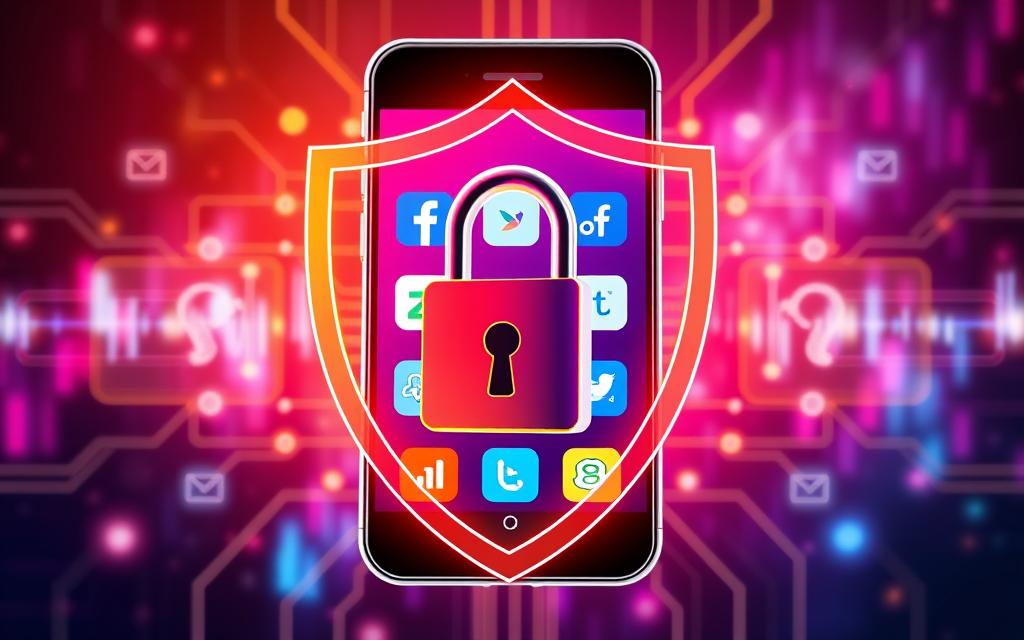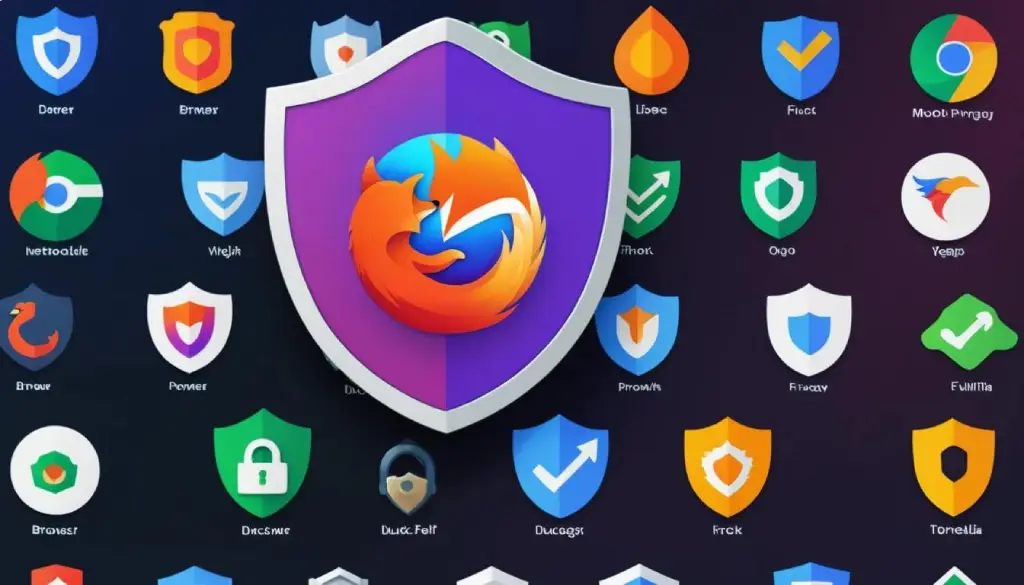How to Secure Your Social Media Accounts: Easy Tips
Learn how to secure your social media accounts with practical tips to protect your data, prevent hacks, and safeguard your online presence effectively.
Are you unknowingly leaving your digital life wide open to intruders? In today’s world, keeping your social media safe is key. We’ve made this guide to help you understand how to protect your online privacy and keep your accounts safe.
From Facebook to Instagram, Twitter to LinkedIn, our social profiles show who we are. But without the right protection, they can be easy targets for hackers. We’ll show you how to make your social media accounts more secure, so your personal info stays private.
By the end of this guide, you’ll know how to make strong passwords, change your privacy settings, and keep your accounts safe. Let’s start and take back control of your digital security.
Understanding Social Media Security Threats
Social media is a big part of our lives, but it also has big security risks. We must know about these dangers to keep our personal info safe online.
Common Types of Social Media Attacks
There are many kinds of social media attacks. Phishing scams try to get us to share our personal info. Account hijacking lets hackers take over our profiles. Malware spreads through links or attachments we click on.
Impact of Security Breaches on Personal Privacy
When our privacy is breached, it can be very bad. Stolen info can lead to identity theft or financial loss. Hackers might also use our accounts to spread false info or harm our friends.
Recent Social Media Security Statistics
Here are some recent security stats:
| Statistic | Value |
|---|---|
| Annual increase in social media attacks | 28% |
| Users who experienced account hacking | 22% |
| Phishing attempts via social platforms | 64% |
| Data breaches involving social media | 56% |
These numbers show how crucial it is to be careful and protect our social media. By knowing these threats, we can stay safer online.
Creating Strong Passwords for Social Media Platforms
Protecting your social media accounts starts with strong passwords. We’ll guide you through best practices, recommend password managers, and show you how to set up multi-factor authentication for extra security.
Password Best Practices
Creating strong passwords is crucial for safeguarding your social media accounts. Use a mix of uppercase and lowercase letters, numbers, and symbols. Aim for at least 12 characters and avoid personal information like birthdays or names.
- Use unique passwords for each account
- Avoid common words or phrases
- Change passwords regularly

Password Manager Recommendations
Password managers help you create and store complex passwords securely. They encrypt your data and make it easy to use unique passwords for all your accounts. Here are some top password managers:
| Password Manager | Features | Price |
|---|---|---|
| LastPass | Cross-platform sync, password generator | Free / $3/month |
| 1Password | Travel mode, secure document storage | $2.99/month |
| Dashlane | VPN included, dark web monitoring | Free / $4.99/month |
Multi-Factor Authentication Setup
Multi-factor authentication adds an extra layer of security to your accounts. It requires a second form of verification beyond your password. Most social media platforms offer this feature. To set it up:
- Go to your account settings
- Look for security or privacy options
- Enable two-factor authentication
- Choose your preferred method (SMS, app, or security key)
By implementing these strategies, you’ll significantly boost your social media security. Strong passwords, password managers, and multi-factor authentication work together to keep your accounts safe from unauthorized access.
How to Secure Your Social Media Accounts
Securing your social media accounts is key in today’s digital world. We’ve put together a list of important steps to protect your online space. By taking these measures, you’ll lower the chance of unauthorized access and data breaches.
Now, let’s look at the main steps to secure your social media accounts:
- Update your passwords regularly
- Enable two-factor authentication
- Review and adjust privacy settings
- Be cautious with third-party apps
- Monitor account activity
By following these steps on all your social media platforms, you’ll build a strong defense against threats. Remember, keeping your social media safe is an ongoing task that needs regular effort and updates.
| Security Measure | Benefit | Difficulty Level |
|---|---|---|
| Regular password updates | Prevents unauthorized access | Easy |
| Two-factor authentication | Adds extra layer of security | Moderate |
| Privacy setting adjustments | Controls information visibility | Easy |
| Third-party app management | Limits data access | Moderate |
| Account activity monitoring | Detects suspicious behavior | Easy |
By adding these social media protection steps to your routine, you’ll build a strong security system for your online accounts. Stay alert and active in keeping your digital space safe.
Privacy Settings Configuration Guide
Securing your social media accounts starts with understanding and configuring platform-specific security options. We’ll guide you through essential privacy settings for popular social networks. This will help protect your personal information.
Facebook Privacy Settings
Facebook offers extensive privacy controls. Go to Settings & Privacy to adjust who can see your posts, friend list, and personal info. Use the Privacy Checkup tool to review and update your settings regularly.
Instagram Security Options
Instagram’s privacy features let you control your account visibility. Set your profile to private, manage story settings, and use Close Friends for sharing select content with a trusted group.
Twitter Protection Features
Twitter provides options to safeguard your tweets and personal data. You can protect your tweets, limit who can tag you in photos, and control direct message permissions in the Privacy and Safety settings.
LinkedIn Privacy Controls
LinkedIn’s privacy settings focus on professional networking safety. Adjust your public profile visibility, control connection requests, and manage who can see your email address or connections list.
| Platform | Key Privacy Features | Where to Find |
|---|---|---|
| Post visibility, Friend list privacy | Settings & Privacy | |
| Private account, Close Friends | Settings > Privacy | |
| Protected tweets, Photo tagging | Settings and privacy > Privacy and safety | |
| Profile visibility, Connection controls | Settings & Privacy > Visibility |
Remember to review these social media privacy settings regularly. Platforms often update their security options. Stay informed about new features to maintain optimal protection for your online presence.
Recognizing and Avoiding Social Media Scams
Social media scams are becoming more common. It’s important to know how to protect ourselves. Scammers try to trick us into sharing personal info or money.
Phishing is a big problem on social media. Scammers send fake messages that look real. They might ask for your personal info or for you to click on bad links.
Scammers also make fake profiles. They pretend to be famous people, businesses, or even friends. Be careful of new friend requests or messages from people you don’t know.
| Common Social Media Scams | Red Flags | Prevention Tips |
|---|---|---|
| Phishing | Urgent requests for personal info | Never click suspicious links |
| Fake Profiles | New accounts with few friends | Verify identity before engaging |
| Lottery Scams | Unexpected prize notifications | Ignore unsolicited winnings |
| Romance Scams | Quick declarations of love | Be cautious of online relationships |
To avoid social media scams, always check who sent you messages or friend requests. Don’t click on links or download attachments from strangers. If something seems too good to be true, it probably is. Keep up with the latest scam tactics to stay safe online.
Managing Third-Party App Permissions
Social media platforms let third-party apps connect to your accounts. These apps can make your experience better but also risk your security. Let’s look at how to handle third-party app permissions and improve your app security.

Reviewing Connected Applications
It’s a good idea to check which apps have access to your social media accounts often. Most platforms show a list of connected apps in your settings. Take time to go through this list and see if each app still needs your data.
Removing Suspicious Apps
If you find any apps you don’t know or don’t trust, remove them right away. It’s easy to do – just click on the app and choose “Remove” or “Revoke Access”. This is a key step to keep your account safe.
Setting App Permission Boundaries
For apps you want to keep, make sure to set clear permission limits. Many apps ask for more access than they really need. Change settings to only give them the access they need, to keep your data safe.
| Permission Type | What It Allows | Security Risk Level |
|---|---|---|
| Read-only | View your profile info | Low |
| Write | Post on your behalf | Medium |
| Full Access | Control your account | High |
By managing third-party app permissions, you greatly improve your social media security. Remember, keeping up with regular reviews and updates is crucial for good app security management.
Device Security for Social Media Access
Keeping your devices secure is key for safe social media use. We’ll look at ways to protect your smartphones, tablets, and computers when using social platforms.
Secure social media access begins with your device. Use strong passwords or biometric locks on all your gadgets. This stops others from getting in if your device is lost or stolen.
Keep your operating systems and apps updated. Updates often include security patches that fight off new threats. Enable automatic updates to stay safe without extra work.
Install reputable antivirus software on your devices. It helps find and remove malware that could harm your social media accounts.
Be careful when using public Wi-Fi networks. Hackers can steal data on unsecured networks. Use a VPN for extra protection when accessing social media in public.
| Device Security Measure | Importance |
|---|---|
| Strong device passwords | Prevents unauthorized access |
| Regular software updates | Protects against new security threats |
| Antivirus software | Detects and removes malware |
| VPN on public Wi-Fi | Encrypts data on unsecured networks |
By using these device security steps, you’ll greatly improve your social media safety. Remember, a secure device is your first defense against online dangers.
Protecting Personal Information Online
In today’s digital world, keeping your personal info safe online is key. We’ll look at ways to protect your data and manage your digital presence.
Information Sharing Guidelines
Be careful with what you share online. Don’t post too much on social media. Avoid sharing personal details like your full birthdate, home address, or phone number.
Also, don’t share where you are or where you’re going. It’s important to keep your location private.

Digital Footprint Management
Your digital footprint is all the data you leave online. Here’s how to manage it well:
- Check and delete old posts on social media
- Use privacy settings to control who sees your stuff
- Google yourself to see what’s out there
- Ask websites to remove personal info you don’t want shared
Location Services Control
Location services can be a privacy risk. Here’s how to stay safe:
- Turn off location services for social media apps when not using them
- Don’t check in at places on social media
- Check app permissions and remove access to location info you don’t need
By following these tips, you’ll greatly improve your online privacy and control over your digital footprint.
Account Recovery Options Setup
Setting up account recovery options is key to keeping your social media profiles safe. We’ll show you how to secure your accounts with backup contact info and other recovery methods.
First, add a backup email address to your accounts. This helps you get back in if your main email is hacked. Most sites let you add more than one recovery email. Think about using both personal and work emails.
Then, add a phone number for SMS verification. This makes your account more secure and helps with recovery. Make sure to update this number if you get a new phone.
Many social networks also offer security questions as a recovery option. Pick answers that only you know, but not too easy to guess. Avoid using your birthplace or your mom’s maiden name.
Here’s a quick guide to setting up recovery options on popular platforms:
| Platform | Recovery Options | Where to Find |
|---|---|---|
| Email, Phone, Trusted Contacts | Settings > Security and Login | |
| Email, Phone | Settings > Security > Account Data | |
| Email, Phone | Settings and Privacy > Your Account | |
| Email, Phone | Settings & Privacy > Sign in & Security |
By setting up these recovery options, you’re protecting your online world. Keep your backup contact info up to date for easy recovery if needed.
Regular Security Maintenance Tips
Keeping your social media accounts safe is an ongoing task. We’ll look at some important strategies for regular security checks. These tips will help protect your online presence.
Security Checkup Schedule
Make a plan for regular social media account checks. Doing this once a month can help spot problems early. During these checks, look at your login history, connected devices, and recent activity for any signs of trouble.
Update Management
Keep up with app and platform updates. These updates often include security fixes. Try to enable automatic updates to make sure you’re always using the latest, safest version.
Backup Strategies
Make it a habit to back up your social media data. Many platforms have tools to help with this. Backups are important because they keep your content and connections safe in case of trouble.
| Maintenance Task | Frequency | Importance |
|---|---|---|
| Security Checkup | Monthly | High |
| Update Apps | As Available | Critical |
| Backup Data | Quarterly | Medium |
| Password Change | Every 6 Months | High |
By following these regular security maintenance tips, you’ll greatly improve your social media account protection. Remember, being consistent is crucial for a secure online presence.
Conclusion
We’ve looked into the world of social media security in this article. We talked about making strong passwords and managing privacy settings. Every step is important to keep your online presence safe.
Protecting your accounts is a continuous task. Be aware of new threats and scams. Keep your apps and devices updated, and check your security settings often. These steps help you stay safe on social platforms.
By following these tips, you’re taking charge of your digital life. We urge you to make social media security a top priority. It’s not just about keeping your data safe. It’s also about feeling secure online. Stay safe, stay smart, and enjoy your social media with confidence!
Worried about social media security? Visit AnonymizeVPN.com for expert tips on how to secure your social media accounts and protect your online identity today!




